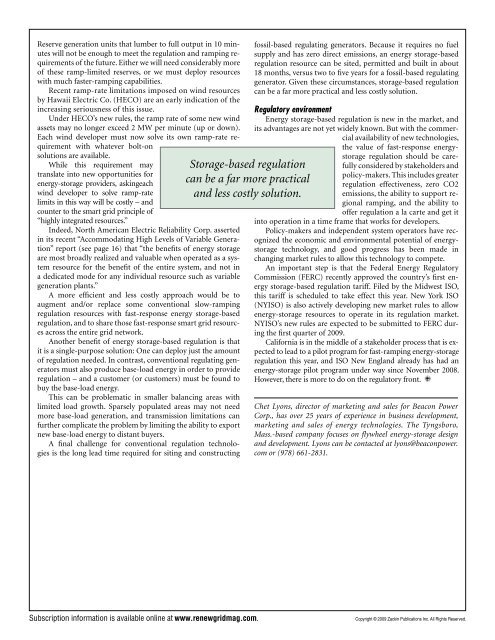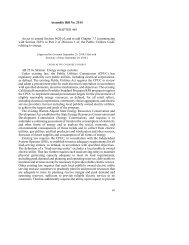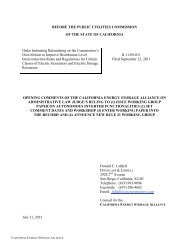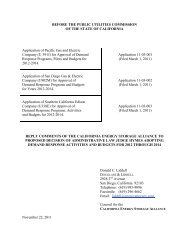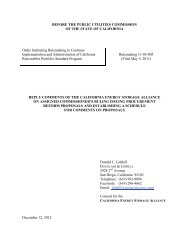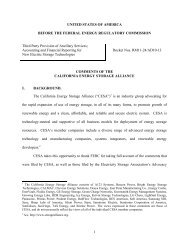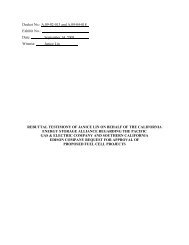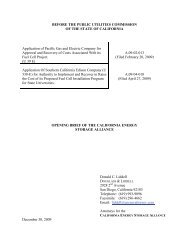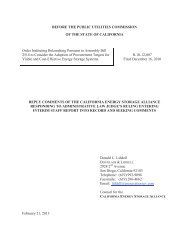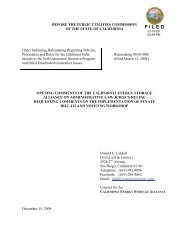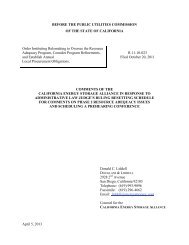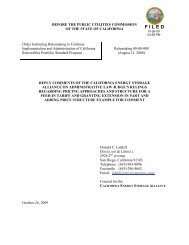A Smart Grid Approach To Regulation And Ramping - California ...
A Smart Grid Approach To Regulation And Ramping - California ...
A Smart Grid Approach To Regulation And Ramping - California ...
You also want an ePaper? Increase the reach of your titles
YUMPU automatically turns print PDFs into web optimized ePapers that Google loves.
Reserve generation units that lumber to full output in 10 minuteswill not be enough to meet the regulation and ramping requirementsof the future. Either we will need considerably moreof these ramp-limited reserves, or we must deploy resourceswith much faster-ramping capabilities.Recent ramp-rate limitations imposed on wind resourcesby Hawaii Electric Co. (HECO) are an early indication of theincreasing seriousness of this issue.Under HECO’s new rules, the ramp rate of some new windassets may no longer exceed 2 MW per minute (up or down).Each wind developer must now solve its own ramp-rate requirementwith whatever bolt-onsolutions are available.While this requirement maytran slate into new opportunities forenergy-storage providers, askingeachwind developer to solve ramp-ratelimits in this way will be costly – andcounter to the smart grid principle of“highly integrated resources.”Indeed, North American Electric Reliability Corp. assertedin its recent “Accommodating High Levels of Variable Generation”report (see page 16) that “the benefits of energy storageare most broadly realized and valuable when operated as a systemresource for the benefit of the entire system, and not ina dedicated mode for any individual resource such as variablegeneration plants.”A more efficient and less costly approach would be toaugment and/or replace some conventional slow-rampingregulation resources with fast-response energy storage-basedregulation, and to share those fast-response smart grid resourcesacross the entire grid network.Another benefit of energy storage-based regulation is thatit is a single-purpose solution: One can deploy just the amountof regulation needed. In contrast, conventional regulating generatorsmust also produce base-load energy in order to provideregulation – and a customer (or customers) must be found tobuy the base-load energy.This can be problematic in smaller balancing areas withlimited load growth. Sparsely populated areas may not needmore base-load generation, and transmission limitations canfurther complicate the problem by limiting the ability to exportnew base-load energy to distant buyers.A final challenge for conventional regulation technologiesis the long lead time required for siting and constructingStorage-based regulationcan be a far more practicaland less costly solution.fossil-based regulating generators. Because it requires no fuelsupply and has zero direct emissions, an energy storage-basedregulation resource can be sited, permitted and built in about18 months, versus two to five years for a fossil-based regulatinggenerator. Given these circumstances, storage-based regulationcan be a far more practical and less costly solution.Regulatory environmentEnergy storage-based regulation is new in the market, andits advantages are not yet widely known. But with the commercialavailability of new technologies,the value of fast-response energystorageregulation should be carefullyconsidered by stakeholders andpolicy-makers. This includes greaterregulation effectiveness, zero CO2emissions, the ability to support regionalramping, and the ability tooffer regulation a la carte and get itinto operation in a time frame that works for developers.Policy-makers and independent system operators have recognizedthe economic and environmental potential of energystoragetechnology, and good progress has been made inchanging market rules to allow this technology to compete.An important step is that the Federal Energy RegulatoryCommission (FERC) recently approved the country’s first energystorage-based regulation tariff. Filed by the Midwest ISO,this tariff is scheduled to take effect this year. New York ISO(NYISO) is also actively developing new market rules to allowenergy-storage resources to operate in its regulation market.NYISO’s new rules are expected to be submitted to FERC duringthe first quarter of 2009.<strong>California</strong> is in the middle of a stakeholder process that is expectedto lead to a pilot program for fast-ramping energy-storageregulation this year, and ISO New England already has had anenergy-storage pilot program under way since November 2008.However, there is more to do on the regulatory front.Chet Lyons, director of marketing and sales for Beacon PowerCorp., has over 25 years of experience in business development,marketing and sales of energy technologies. The Tyngsboro,Mass.-based company focuses on flywheel energy-storage designand development. Lyons can be contacted at lyons@beaconpower.com or (978) 661-2831.Subscription information is available online at www.renewgridmag.com.Copyright © 2009 Zackin Publications Inc. All Rights Reserved.


